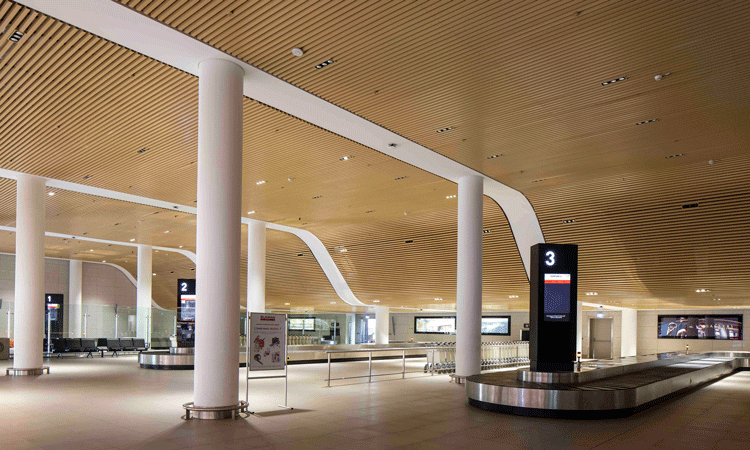The importance of baggage handling systems in winning passengers and airlines
- Like
- Digg
- Del
- Tumblr
- VKontakte
- Buffer
- Love This
- Odnoklassniki
- Meneame
- Blogger
- Amazon
- Yahoo Mail
- Gmail
- AOL
- Newsvine
- HackerNews
- Evernote
- MySpace
- Mail.ru
- Viadeo
- Line
- Comments
- Yummly
- SMS
- Viber
- Telegram
- Subscribe
- Skype
- Facebook Messenger
- Kakao
- LiveJournal
- Yammer
- Edgar
- Fintel
- Mix
- Instapaper
- Copy Link
Posted: 11 November 2021 | Mehmet Mercan | No comments yet
Mehmet Mercan, Operations Director at Diori Hamani International Airport (NIM), explains how an airport’s baggage systems are used as a key performance and a service quality indicator which is crucial to winning passengers and airline business.


Airports have become larger and more comfortable structures day by day, and the time factor in airport operations has become an important performance criterion for both passengers and operators. The time factor has become the reason for preference, especially for transit passengers at transfer points. The efficiency of the systems, which we can call the veins of the airport, started to gain importance.
The baggage handling system (BHS) used at airports is one of the most complex systems. It is a special structure that includes both mechanical and electro-mechanical engineering concepts within the system. The baggage handling system is responsible for ensuring that the baggage of the passengers arriving at the airport is transported safely to baggage trolleys or containers after check-in, checking the baggage for security, security screening, sorting and storage. This system basically consists of conveyors that are connected to each other and form a whole system.
In terms of both operational efficiency, safety and passenger satisfaction, the baggage handling system constitutes the most important service network of airports.”
Any technical failure may affect the entire workflow and system of the airports. Problems such as power outages, lack of a spare baggage transport plan, spare parts supply and system failures can cause the entire operation to stop within minutes. For this reason, many issues should be considered when planning this system. A replacement period should be determined according to the location and working principle of the spare parts, and necessary changes should be made before the parts fail.
A service quality indicator
Baggage systems are an important indicator of the airport’s service quality. It is considered as one of the most important key performance indicators. Inefficient baggage handling systems lead to passenger and airline dissatisfaction. This reduces the preferability of the airport operator. In addition, the competition between airports, which is becoming more fierce day-by-day, for passengers and airlines also makes service quality an important factor. Using fast transfer baggage systems for transfer, outbound or inbound baggage attracts new airlines to the airport as a destination or hub and motivates passengers. It offers an attraction to use the same airport in the future. Breakdowns experienced during peak hours at some airports not only negatively affect customer satisfaction, but also cause airline delays and create additional costs. Especially at airports with a large number of transit passengers, these systems must be efficient and work correctly. There may be cases where the passenger cannot catch the next flight and the luggage cannot be loaded. For this reason, passenger satisfaction and baggage loss cases should be evaluated as an inverse correlation. As the technologies related to these systems used at airports develop, special tracking systems are integrated and passenger satisfaction is improved.
Following the baggage journey through mobile devices
Passengers who can follow the journey of their luggage through live data experience a happier travel experience. SITA’s research shows that 26 per cent of passengers in 2018 used their mobile device to receive status updates on their baggage at arrival, up from 14 per cent in 2017. At the same time, there is a growing demand from passengers to receive more baggage information via their mobile devices. A majority of passengers said they would definitely use mobile notifications providing information on baggage at arrival, while a similar proportion said they would use their mobiles to track their bags or to report mishandled baggage.


Baggage collection at Diori Hamani International Airport. Credit: Diori Hamani International Airport (NIM).
These mobile services have dramatically improved passenger satisfaction levels. In 2018, those travellers who used their mobile to receive updates at baggage collection were 8.6 per cent more satisfied than those who relied on traditional voice announcements or flight information screens for information.
The design process
The airport operator must ensure the necessary co-ordination between the baggage handling system supplier and the relevant authorities. In terms of security, it should be compatible with the national legal rules and regulations of the relevant country. This situation is of vital importance in terms of procedure, technique and operation. In particular, while carrying out the operational readiness activation and transition (ORAT) process, the opinions of all stakeholders should be sought, and a system flow should be determined in accordance with the operational procedures. X-ray and tracking systems that will work integrated with the baggage handling system should likewise be planned to meet the needs of all stakeholders who will benefit from this system.
While designing the baggage handling system, it should be planned so as not to cause baggage delay. Managing the luggage area with an efficient system provides an advantage in terms of space usage. Especially in the design of new airports, the areas where the luggage system will be installed and the systems to be used should be compared, and the most efficient and cost-effective optimisation should be considered. As the baggage handling system becomes important, bag storage, video detection and bag tracking systems that work integrated with this system are being developed. Especially at airports with a large number of transit passengers, big data is created by examining baggage handling system and tracking data, and studies are carried out to make the system more efficient with this data. Baggage handling systems include ticket/check-in conveyor, queue conveyor, power turn, spiral turn, merges, high speed diverter, vertical sorter, transport conveyor, plough merge, make-up carrousel, chute and roller conveyor parts. These parts are used according to the size of the area. According to the airport passenger density, a more effective conveyor and baggage route planning can be made by negotiating with the manufacturer.
Factors such as the design of the conveyors to optimise efficiency, the short maintenance period of the parts and the fact that the check-in process is not difficult for the teams, the luggage goes to the plane in the right flow and the safety modules such as the Explosive Detective System (EDS) are working correctly, are very important. Luggage waiting times and distance optimisations at the entrance conveyor in the check-in area should be well adjusted and measures should be taken to prevent luggage congestion.
At Diori Hamani International Airport (NIM) we are working with Dimark on the baggage handling system. Our airport has a total of 12 check-in counters and an associated departure conveyor system. We have also a total of three arrival conveyors, two in the international arrival region and one in the domestic arrival region. We are constantly striving to innovate and optimise the system so that our passengers continue to choose us and our airlines continue to fly with us.
Biography


Issue
Related topics
Airport development, Baggage handling, Passenger experience and seamless travel, Security, Terminal operations


















